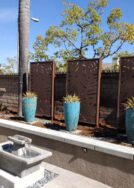The dirt below our feet is an ocean filled with micro-organisms, and a home to many critters and all types of burrowing animals. Dig deep enough and you may encounter relics of the past-fossilized remains of another world. Well, luckily, we don’t need to dig that deep to plant a vegetable garden, but we do need to know what lies below the surface where a vegetable garden is planned.
Healthy garden soil is not hard to develop but it sometimes takes more than a season unless you purchase prepared soil; either way, start with a soil test. A soil test will reveal the deficiencies in your existing soil, and help you pinpoint the improvements needed for growing tasty vegetables. Basic soil test kits are available online, at garden centers, and big box stores. Comprehensive soil tests are available through agricultural and fertilizer suppliers, private soil labs, and through the USDA. In addition to testing soil ph and nutrient levels of nitrogen, potassium, and phosphorus (NPK), a professional lab can also test your soil microbiology to determine the level of activity. Additional nutrients required for healthy plant growth are referred to as micro-nutrients. These nutrients are required in much smaller quantities than NPK but are important.
A high level of biological activity is found in healthy soils. It involves the complex interactions between micro-organisms and soil inhabitants like earthworms and the ever-present tree roots. Most soil micro-organisms are beneficial to plant growth and health. The mycorrhiza fungus in particular is one such organism, that improves plant health by improving a plants ability to obtain nutrients. In exchange, the plant provides the fungus with food and sugars produced during photosynthesis. Mycorrhiza fungus is available as a soil additive and should be a part of your soil health improvement process. You should know that the association between plant and soil fungi is a delicate and balanced one. Anything you do to improve your soil, specifically fertilizing, can harm these living soil organisms, so avoid using chemically derived inorganic fertilizers and soil fumigants. For vegetables, use organic fertilizers derived from natural sources. Organic fertilizers are lower in nutrients than nitrate-based fertilizers and provide a steady supply of nutrients for normal growth without the up and down growth spurts associated with high nitrogen fertilizers.
Healthy soils will have good drainage and texture. Good soil drainage allows water to saturate the roots and continue down to a lower soil level. Poorly draining soils do not allow water to travel past plant roots, causing it to remain there for a long period of time, which can lead to plant disease or death. Soil contains small and large particles. The smallest particles are microscopic, and they form dense soils normally higher in nutrients that drain poorly. The largest particles are basically sand that is nutrient deficient and drains too quickly. A suitable combination of the two provides a soil that crumbles in your hand after squeezing it. It should not run through your fingers like sands in an hourglass or remain tight like a piece of Play Dough. How do you know if your soil is draining properly?
- Dig a12” wide x 12” deep square hole.
- Fill it with water to the top.
- Check to see how long it takes that water to drain.
- It should be gone within an hour.
For additional facts and information about improving your soil drainage and your overall soil health follow the link below to the USDA website. In the meantime, here are a few points keep in mind when improving your soil and keeping it clean and healthy. Good Luck!
HERE ARE SOME RECOMMENDATIONS TO FOLLOW FOR HEALTHY GARDEN SOIL
- READ THE LABELS OF ALL PRODUCTS YOU PLAN TO USE
- DO NOT USE WEED KILLERS, SOIL FUMIGANTS, OR FUNGICIDES.
- TEST YOUR SOIL WITH A HOME TEST KIT OR THROUGH A PROFESSIONAL SOIL LAB.
- FOLLOW THE SOIL REPORT RECOMMENDATIONS FOR IMPROVING YOUR SOIL.
- USE PROCESSED AND AGED AND APPROVED ORGANIC SOIL AMENDEMENTS.
- AVOID RAW FARM ANIMAL MANURES NOT PROCESSED AND/OR PROPERLY AGED.
- AVOID CHEMICAL FERTILIZERS AND USE ORGANIC FERTILIZERS EXCLUSIVELY THAT AREA DERIVED FROM NATURAL SOURCES.
- INCLUDE MYCORRHIZA SOIL FUNGI TO IMPROVE THE AVAILABILITY OF NUTRIENTS.
- CHECK YOUR GARDEN SOIL FOR PROPER DRAINAGE.
- IF THE SOIL CONDITION IS POOR, BUILD GARDEN BOXES. RAISED GARDEN BEDS ARE GREAT FOR GARDENERS WITH MOBILITY ISSUES AS WELL.




